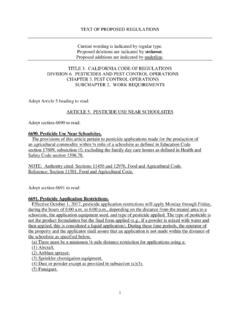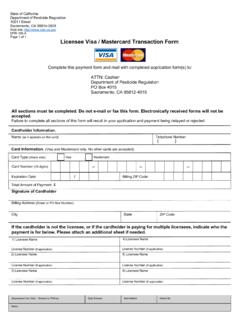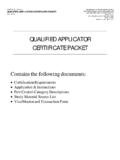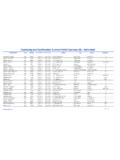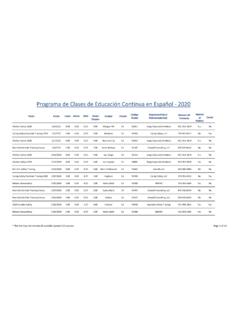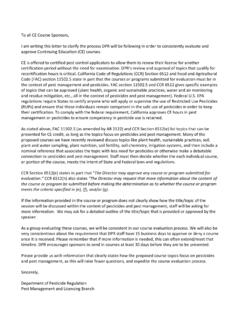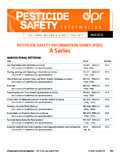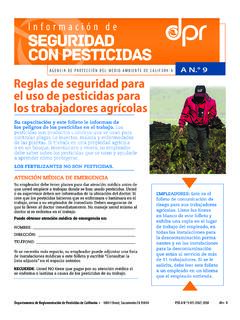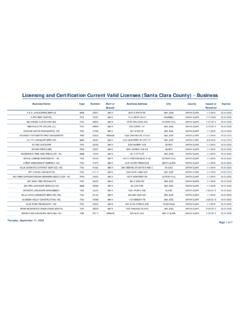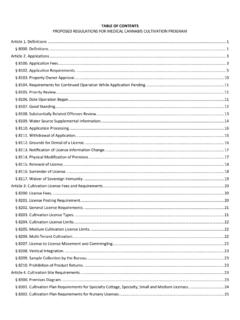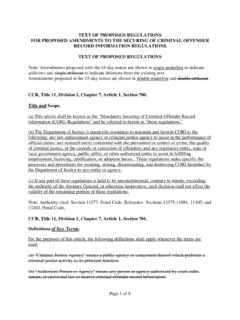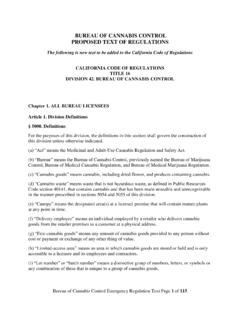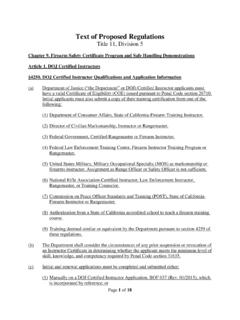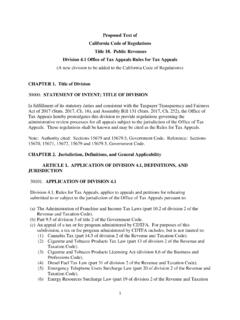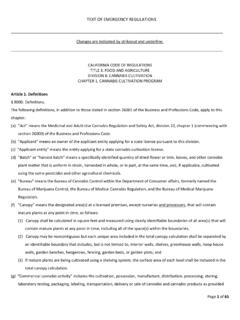Transcription of Text of Proposed Regulations - cdpr.ca.gov
1 1 TEXT OF Proposed Regulations Current wording is indicated by regular type. Proposed deletions are indicated by strikeout. Proposed additions are indicated by underline. TITLE 3. CALIFORNIA CODE OF Regulations DIVISION 6. PESTICIDES AND PEST CONTROL OPERATIONS CHAPTER 2. PESTICIDE REGULATORY PROGRAM SUBCHAPTER 1. DEFINITION OF TERMS ARTICLE 1. DEFINITIONS FOR DIVISION 6 Amend section 6000 to read: 6000. Definitions.. "Application exclusion zone" means the area surrounding the application equipment that must be free of all persons other than appropriately trained and equipped handlers during pesticide applications.. NOTE: Authority cited: Sections 11456, 11502, 12111, 12781, 12976, 12981, 13145, 14001, and 14005, Food and Agricultural Code. Reference: Sections , 11408, 11410, 11501, 11701, 11702(b), 11704, 11708(a), 12042(f), 12103, 12971, 12972, 12973, 12980, 12981, 13145, 13146, and 14006, Food and Agricultural Code. CHAPTER 3. PEST CONTROL OPERATIONS SUBCHAPTER 2.
2 WORK REQUIREMENTS ARTICLE 1. PEST CONTROL OPERATIONS GENERALLY Amend section 6619 to read: 6619. Notice of Completed Applications. (a) Any person applying pesticides for the commercial or research production of an agricultural plant commodity shall assure that the operator of the property treated receives notice, orally or in writing, and within 24 hours of completion of the pesticide application. This notice must include the following information: (1) The location of the property, including the site identification number, and acreage treated; (2) The pesticide product name(s), EPA registration number(s), and active ingredient(s); (3) Spray adjuvant product name(s) and California registration number(s), if applicable; (4) The date(s) and time(s) the application started and ended; and (5) The applicable reentry and pre-harvest intervals, unless a copy of a written recommendation for the subject application made by a licensed agricultural pest control adviser, properly completed, was given to the operator of the property treated.
3 2 (b) The operator of the treated property shall maintain a written record of the application(s) ontheir property. These records must include the date(s) and time(s) the application started andended notice information specified in (a)(1-5). (c) The operator of the property shall assure that notice of completed application is given to employees covered under section 6700 (which includes fieldworkers) and their employers except as provided in (e). The operator of the property is not required to provide notice to persons who will apply the pesticide(s) or supervise the application for which the notice is intended.. NOTE: Authority cited: Sections 11456, 12796, and 12981, Food and Agricultural : Sections 11501 and 12981, Food and Agricultural Code. SUBCHAPTER 3. PESTICIDE WORKER SAFETY ARTICLE 1. GENERAL SCOPE AND PURPOSE Amend section 6724 to read: 6724. Handler Training. The employer shall assure that employees who handle pesticides have been trained pursuant to the requirements of this section and that all other provisions of this section have been complied with for employees who handle pesticides.
4 (a) The employer shall have a written training program. The training program shall describe the materials ( , study guides, pamphlets, pesticide product labeling, Pesticide Safety Information Series leaflets, Safety Data Sheets, slides, video ta pes) and information that will be provided andused to train his or her employees and identify the person or firm that will provide the training program shall address each of the subjects specified in subsection (b) that is applicable to the specific pesticide handling situation. The employer shall maintain a copy of thetraining program while in use and for two years after use, at a central location at the workplace. (b) The training shall cover, for each pesticide or chemically similar group of pesticides, to be used: (1) Format and meaning of information, such as precautionary statements about human health hazards, contained in pesticide product labeling; (2) Hazards of pesticides, including acute chronic, delayed effects, and sensitization, asidentified in pesticide product labeling, Safety Data Sheets, or Pesticide Safety InformationSeries leaflets; Applicator s responsibility to protect persons, animals, and property while applying pesticides; and not to apply pesticides in a manner that results in contact with personsnot involved in the application process; (3) Need for limitations, appropriate use, removal, and sanitation, of, any required personal protective equipment.
5 (4) Safety requirements and procedures, including engineering controls (such as closed mixing systems and enclosed cabs) for handling, transporting, storing, disposing of pesticides, and spill clean-up; (5) Where and in what forms pesticides may be encountered, including treated surfaces, residues on clothing, personal protective equipment, application equipment, and drift; 3 (6) Hazards of pesticides, including acute, chronic, and delayed effects, and sensitization effects, as identified in pesticide product labeling, Safety Data Sheets, or Pesticide Safety Information Series leaflets; (37) Routes by which pesticides can enter the body; (48) Signs and symptoms of overexposure; (9) Routine decontamination procedures when handling pesticides, including that employees should: (A) Wash hands before eating, drinking, using the toilet, chewing gum, or using tobacco; (B) Thoroughly wash or shower with soap and water; (C) Change into clean clothes as soon as possible; and (D) Wash work clothes separately from other laundry before wearing them again.
6 (5) Emergency first aid for pesticide overexposure; (10) How Safety Data Sheets provide hazard, emergency medical treatment, and other information about the pesticides with which employees may come in contact; (11) The hazard communication program requirements of section 6723; (12) The purposes and requirements for medical supervision if organophosphate or carbamate pesticides with the signal word "DANGER" or "WARNING" on the labeling are mixed, loaded, or applied for the commercial or research production of an agricultural plant commodity; (6) How to obtain emergency medical care; (713) Routine First aid and emergency decontamination procedures, including spill clean-up and emergency eye flushing techniques; and if pesticides are spilled or sprayed on the body towash immediately with decontamination supplies and as soon as possible, wash or shower withsoap and water and change into clean clothes the need to thoroughly shower with soap and warmwater after the exposure period ; (14) How and when to obtain emergency medical care; (8) Need for, limitations, appropriate use, and sanitation, of, any required personal protective equipment; (915) Prevention, recognition, and first aid for heat-related illness in accordance with Title 8 of the California Code of Regulations , section 3395; (1016) Safety requirements and procedures, including engineering controls (such as closedsystems and enclosed cabs) for handling, transporting, storing, and disposing of pesticides Requirements of this chapter and chapter 4 relating to pesticide safety, Safety Data Sheets, andPesticide Safety Information Series leaflets.
7 (17) The requirement that handlers of pesticides used in the commercial or research production of an agricultural commodity must be at least 18 years of age; (1118) Environmental concerns such as drift, runoff, and wildlife hazards; (19) Field posting requirements and restricted entry intervals when pesticides are applied for the commercial or research production of an agricultural commodity; (1220) Warnings about That employees should not takingtake pesticides or pesticide containershome from work; (21) Potential hazards to children and pregnant women from pesticide exposures, including that: (A) Children and nonworking family members should keep away from treated areas; (B) After performing handling activities or after working in a treated area, employees should remove boots or shoes before entering the home and remove work clothes; and (C) Employees should wash or shower before physical contact with children or family members. 4 (22) How to report suspected pesticide use violations; and (13) Requirements of this chapter and chapter 4 relating to pesticide safety, Safety Data Sheets, and Pesticide Safety Information Series leaflets; (14) The purposes and requirements for medical supervision if organophosphate or carbamate pesticides with the signal word "DANGER" or "WARNING" on the labeling are mixed, loaded, or applied for the commercial or research production of an agricultural plant commodity; (15) The location of the written Hazard Communication Information For Employees Handling Pesticides (Pesticide Safety Information Series leaflet A-8), other Pesticide Safety Information Series leaflets, and Safety Data Sheets; (1623) The employee's rights, including the right;: (A) To personally receive information about pesticides to which he or she may be exposed.
8 (B) For his or her physician or an employee representative designated in writing to receive information about pesticides to which he or she may be exposed; and (C) To be protected against retaliatory action due to the exercise of any of his or her rights.; and (D) To report suspected use violations to the Department or county agricultural commissioner. (c) The training shall be in a manner the employee can understand, be conducted pursuant to the written training program, and include response to questions. Training for employees handling pesticides used for the commercial or research production of an agricultural commodity must be at a location reasonably free from distraction and trainers must be present throughout the entire presentation. (d) Training shall be completed before the employee is allowed to handle pesticides, continually updated to cover any new pesticides that will be handled, and repeated at least annually thereafter. Initial training may be waived if the employee submits a record showing that training meeting the requirements of this section and covering the pesticides and use situations applicable to the new employment situation was received within the last year.
9 A certified applicator is considered trained for the purposes of this section. (e) The date and extent of initial and annually required training given to the employee and the job to be assigned shall be recorded. This record shall be verified by the employee's signature and retained by the employer for two years at a central location at the workplace accessible to employees. For an employee handling pesticides used for the commercial or research production of an agricultural commodity, the record must also include employee s printed name; the title(s) and source(s) of the training materials used; employer's name; and trainer s name and qualifications as specified in (f). (f) The person conducting the training for employees who will be handling pesticides for the commercial or research production of an agricultural plant commodity shall be qualified as one of the following: (1) A California certified commercial applicator; (2) A California certified private applicator; (3) A person holding a valid County Biologist License in Pesticide Regulation or Investigation and Environmental Monitoring issued by the Department of Food and Agriculture; (4) A farm advisor employed by the University of California Extension OfficeAdvisor; (5) A person who has completed an "instructor trainer" program presented by one of the following: (A) the University of California, Integrated Pest Management Program; or (B) other instructor training program approved by the Director; (6) A California licensed Agricultural Pest Control Adviser; 5 (7) A California Registered Professional Forester.
10 Or (8) Other trainer qualification approved by the Director. NOTE: Authority cited: Section 12981, Food and Agricultural Code. Reference: Sections 12980 and 12981, Food and Agricultural Code. Amend section 6764 to read: 6764. Fieldworker Training. (a) The employer shall assure that each employee assigned to work in a treated field has been trained within the last 12 months, in a manner the employee understands, before beginning work in the treated field. (b) The training shall include the following information: (1) Importance of routine decontamination and washing thoroughly after the exposure period; Where and in what forms pesticides may be encountered, including treated surfaces in the field, residues on clothing, personal protective equipment, application and chemigation equipment, irrigation water, and drift; (2) Restricted entry intervals and what posting means, including both California and federalfield posting sign formats; Potential hazards that pesticides present to fieldworkers and theirfamilies including acute, chronic, and delayed effects, and sensitization effects; (3) Where pesticides are encountered, including treated surfaces in the field, residues onclothing, chemigation and drift; (4) Routes of exposure by which pesticides can enter the body; (5) The hazards of pesticides, including acute effects, chronic and delayed effects, and sensitization effects.
